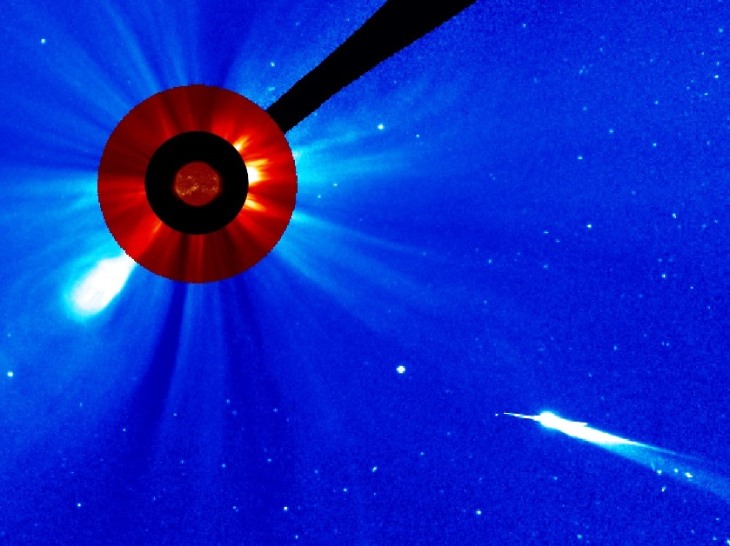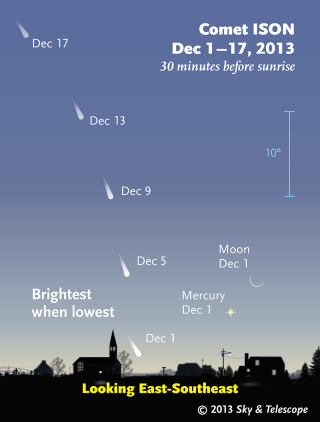Published on Nov 27, 2013
LINKS; LIVE SDO http://cometison.gsfc.nasa.gov/# LIVE COUNTDOWN http://www.cometison2013.co.uk/perihe...
SOLAR and QUAKE LINKS http://www.BPEarthWatch.Com
SOLAR and QUAKE LINKS http://www.BPEarthWatch.Com
..........
Published on Nov 27, 2013
..........
NBC News

For more than a year, Comet ISON has been taking
skywatchers on a roller-coaster ride, but the most dramatic thrill is
coming up on Thursday — and the prospects look good for a spectacular
show.
Over the course of less than a day, the comet's brightness "has increased by at least a factor of four, and indications are it may be closer to a factor of 10," the NASA Comet ISON Observing Campaign reported on Wednesday.
When we last checked in with what was once called the "comet of the century," ISON was heading toward the sun at the same time that a solar storm was pushing outward. Karl Battams, an astrophysicist at the Naval Research Laboratory who's part of the observing campaign, was almost gleeful over the prospect that the cosmic storm cloud would interact with the comet's tail.
However, it turned out that the cloud of electrically charged particles, also known as a coronal mass ejection, had no significant effect. "The source of the cloud is a farside active region, which is not directly facing the comet," SpaceWeather.com's Tony Phillips reported.
Even
if the outburst had swept directly over ISON, that alone wouldn't have
caused the comet to break up. However, some observers wondered whether
the comet's nucleus or tail is being disrupted. So far, the images from
the Solar and Heliospheric Observatory's LASCO C3 detector suggest that ISON is keeping it together. Mostly.
Battams reported that the comet had brightened to around magnitude +0.5, which is as bright as the star Betelgeuse in the "shoulder" of the constellation Orion. What's more, ISON appears to be behaving like a classic sungrazing comet. That is, it's behaving like Comet Lovejoy (C/2011 W3), which weathered its whirl around the sun and dazzled the Southern Hemiphere two years ago.
"We cannot comment on whether the nucleus is intact or not, but our analyses indicate that its rate of brightening is directly in line with that we have experienced with other sungrazing comets," Battams wrote. "This has no implications on its chances of survival."

Battams and his colleagues on
the observing campaign advised solar observatories to watch for the
comet to get even brighter as it rounds the sun. They also advised
casual observers not to try looking for ISON in the sky over the next
couple of days, due to the risk of eye damage. (But if you're set on
trying, Sky & Telescope's Alan McRobert provides an observing guide.)
The best bet is to monitor the comet's passage online.
NBC News
Comet ISON brightens as it closes in on Thanksgiving's solar climax
4 hours ago

NASA / SDO / ESA / SOHO / Helioviewer.org
A composite image, based on data from NASA's Solar Dynamics Observatory
and the Solar and Heliospheric Observatory, shows the sun and its
coronal activity as well as Comet ISON approaching from the lower right.
Over the course of less than a day, the comet's brightness "has increased by at least a factor of four, and indications are it may be closer to a factor of 10," the NASA Comet ISON Observing Campaign reported on Wednesday.
When we last checked in with what was once called the "comet of the century," ISON was heading toward the sun at the same time that a solar storm was pushing outward. Karl Battams, an astrophysicist at the Naval Research Laboratory who's part of the observing campaign, was almost gleeful over the prospect that the cosmic storm cloud would interact with the comet's tail.
However, it turned out that the cloud of electrically charged particles, also known as a coronal mass ejection, had no significant effect. "The source of the cloud is a farside active region, which is not directly facing the comet," SpaceWeather.com's Tony Phillips reported.
A series of images from the SOHO spacecraft shows Comet ISON approaching the sun as a solar storm sweeps outward.
Battams reported that the comet had brightened to around magnitude +0.5, which is as bright as the star Betelgeuse in the "shoulder" of the constellation Orion. What's more, ISON appears to be behaving like a classic sungrazing comet. That is, it's behaving like Comet Lovejoy (C/2011 W3), which weathered its whirl around the sun and dazzled the Southern Hemiphere two years ago.
"We cannot comment on whether the nucleus is intact or not, but our analyses indicate that its rate of brightening is directly in line with that we have experienced with other sungrazing comets," Battams wrote. "This has no implications on its chances of survival."

Sky & Telescope
Assuming
that Comet ISON survives, here's where to look for it in pre-dawn skies
during December. The Sky & Telescope chart is drawn for skywatchers
near 40 degrees latitude (Denver, New York, Madrid) but should serve
for most northern temperate latitudes. The blue 10-degree scale is about
the width of your fist held at arm's length. Check SkyandTelescope.com
for more charts and updates.
The best bet is to monitor the comet's passage online.
Read More Here
..........
..........







No comments:
Post a Comment
Hello and thank you for visiting my blog. Please share your thoughts and leave a comment :)